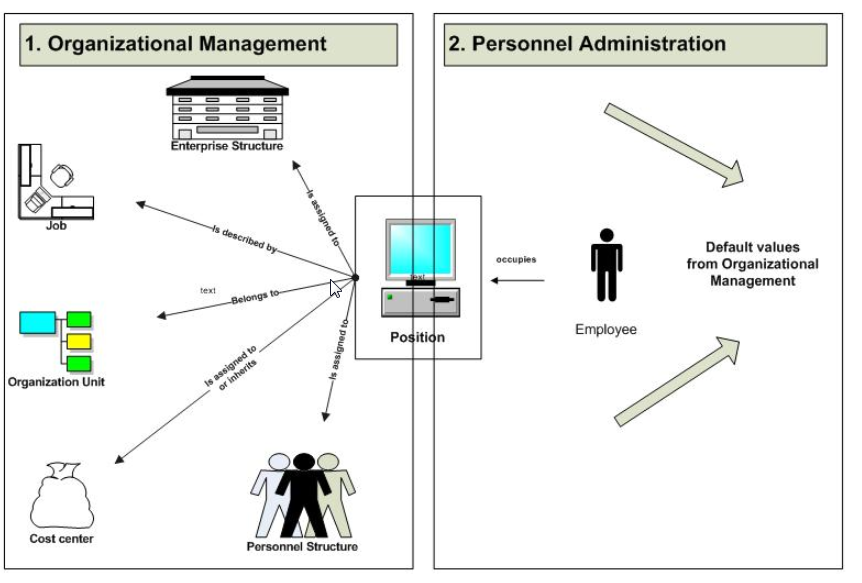 An Employee in SAP HCM Organizational Structure, Personnel Structure and Enterprise Structure
An Employee in SAP HCM Organizational Structure, Personnel Structure and Enterprise Structure
Welcome to the tutorial about SAP HCM Organizational Structure. After completing this tutorial you will get initial understanding about maintaining an organizational structure of an enterprise in the Organization Management submodule of SAP HCM.
There are 3 fundamental structures in SAP HCM:
Enterprise and Personnel structures are part of the Personnel Management and Organization structure is part of Organizational Management (OM) submodule of SAP HCM.
The assignment to those 3 structures must allow to precisely locate any employee in the organization. Those structures are used to:
 An Employee in SAP HCM Organizational Structure, Personnel Structure and Enterprise Structure
An Employee in SAP HCM Organizational Structure, Personnel Structure and Enterprise Structure
Now, let’s discuss SAP HCM organizational structure in more details. The organizational unit is a box in the pyramid of the organizational chart: a business unit, a department, a team, etc.
The position can be seen as a chair, on which will seat an employee, or a person.
Those objects are far from being the only ones existing in Organizational Management (OM) and will be detailed later on in this presentation.
 An Organizational Structure
An Organizational Structure
OM uses the concept of object and relationship. The following rules apply:
 The Concept of Relationship between Objects
The Concept of Relationship between Objects Different Types of Objects in SAP HCM
Different Types of Objects in SAP HCM
For various purposes, positions that share common characteristics may need to be grouped. This is done using the notion of job. It is used for instance to make easier maintenance of required qualifications, creation of requisitions for recruitment, or simply for reporting.
 A Job and Positions
A Job and Positions
All these objects are linked in an organizational structure with so called ‘relationships’. These assignments between objects intend to cover the following business issues in the system:
Define assignments between objects to describe their hierarchical relationship to each other. For example, you assign organizational units to each other hierarchically to represent the organizational structure of your enterprise or your organization and assign the individual organizational units to the positions that belong to them. You also use assignments to state which employee staffs which position.
It is possible to use assignments to define object characteristics if own object types are planned to represent these characteristics in the system in the data model for the component Personnel & Organization. You can use the assignment of jobs to positions to describe the characteristics.
It is possible to use assignments to represent relationships between objects of the component Personnel & Organization and objects of other components in the system. You can thus assign organizational units or positions to cost centers to represent the relationship between the organizational structure and the cost center structure.
 An Example of SAP HCM Organizational Structure
An Example of SAP HCM Organizational Structure
When assigning an employee to a position in the infotype 0001 (Organizational Assignment), a link is created between the employee and the position in OM.
 A Position in Organizational Management (OM) and Personnel Administration
A Position in Organizational Management (OM) and Personnel Administration
The relationship between a position and a person holds a notion of staffing percentage. This percentage needs to be correctly set to reflect the real situation. Mostly this will be set to 100%, but it may be otherwise. This is typically the case of “double hats” (people that occupy two or more positions at the same time):
 One Person Occupies Two Positions at the Same Time with Different Staffing Percentage
One Person Occupies Two Positions at the Same Time with Different Staffing Percentage
This represents employees splitting their time between two (or more) positions.
Below is the list of common transactions to display, create or change the organizational structure in SAP:
PP01 – Maintain Plan Data
PPOME – Change Organization and Staffing
PP02 – Maintain Plan Data
PPOSE – Display organization and Staffing Basis – Organizational Management
PPOCE – Create Organization and Staffing Basis – Organizational Management
PO10 – Maintain organizational units
PO13 – Maintain positions
PPOSE/PPOME are very complete transactions which give many display possibilities:
With these transactions you can
 Display Planned Movements of Employees within a Company
Display Planned Movements of Employees within a Company![]() Change Display Date
Change Display Date
 Change the View
Change the View Different Options for Search
Different Options for Search
Organizational units and positions should be modified only using transaction PP01, PO10 (organizational units only) or PO13 (positions only). They are more expert oriented and give you the full control over what you’re modifying and access to all the infotypes.
Whichever transaction is used, it is important to correctly manage dates. Indeed, the date on which data is starting in the SAP system must reflect the reality. For instance, if you decide to change an organizational unit title, then you would want to keep the historical name and date before changing to the new name before the real start date.
 Changing a Name of Organizational Unit
Changing a Name of Organizational Unit
PP01 is an expert transaction which allows accessing all the infotypes available for a particular object. It handles the following situations:
—